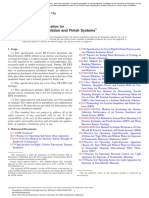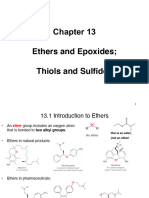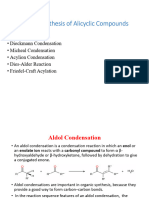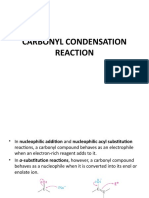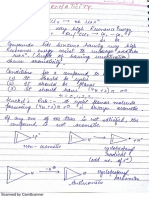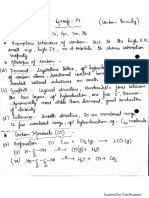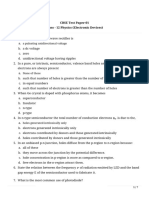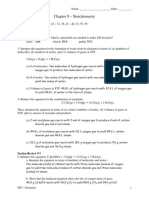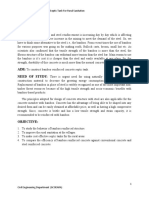Ch22 CA Deriv B PRINT
Ch22 CA Deriv B PRINT
Uploaded by
booma0 ratings0% found this document useful (0 votes)
43 views7 pagesAnhydrides readily react with nucleophiles through nucleophilic attack at one carbonyl group. This forms a new bond to the nucleophile and a leaving group from the second carbonyl. Nitriles can be hydrolyzed to form carboxylic acids or reduced to primary amines. β-Lactam antibiotics kill bacteria through nucleophilic acyl substitution with bacterial cell wall transpeptidase enzymes, inactivating the enzymes.
Original Description:
Original Title
Ch22-CA-Deriv-B-PRINT
Copyright
© © All Rights Reserved
Available Formats
PDF, TXT or read online from Scribd
Share this document
Did you find this document useful?
Is this content inappropriate?
Report this DocumentAnhydrides readily react with nucleophiles through nucleophilic attack at one carbonyl group. This forms a new bond to the nucleophile and a leaving group from the second carbonyl. Nitriles can be hydrolyzed to form carboxylic acids or reduced to primary amines. β-Lactam antibiotics kill bacteria through nucleophilic acyl substitution with bacterial cell wall transpeptidase enzymes, inactivating the enzymes.
Copyright:
© All Rights Reserved
Available Formats
Download as PDF, TXT or read online from Scribd
Download as pdf or txt
0 ratings0% found this document useful (0 votes)
43 views7 pagesCh22 CA Deriv B PRINT
Ch22 CA Deriv B PRINT
Uploaded by
boomaAnhydrides readily react with nucleophiles through nucleophilic attack at one carbonyl group. This forms a new bond to the nucleophile and a leaving group from the second carbonyl. Nitriles can be hydrolyzed to form carboxylic acids or reduced to primary amines. β-Lactam antibiotics kill bacteria through nucleophilic acyl substitution with bacterial cell wall transpeptidase enzymes, inactivating the enzymes.
Copyright:
© All Rights Reserved
Available Formats
Download as PDF, TXT or read online from Scribd
Download as pdf or txt
You are on page 1of 7
General Reaction of Anhydrides Reactions of Anhydrides
• Anhydrides are somewhat less reactive than acid chlorides, but
still readily react with most nucleophiles.
• Nucleophilic attack occurs at one carbonyl group, while the second
carbonyl becomes part of the leaving group.
Mechanism of Anhydride Substitution Anhydrides Use in Acetylation Reactions
• Reactions that result in the transfer of an acetyl group are known
• Besides the usual steps for nucleophilic addition and elimination of the as acetylations.
leaving group, the mechanism involves an additional proton transfer.
General Reactions of Carboxylic Acids Acyl Substitution Reactions of Carboxylic Acids
• Nucleophiles that are also strong bases react with carboxylic acids by
removing a proton first, before any nucleophilic substitution reaction
can take place.
• The first reaction – a simple Bronsted-Lowry acid-base reaction – is
both kinetically and thermodynamically favored with most common
nucleophiles.
Dehydration of Carboxylic Acids Fischer Esterification of Carboxylic Acids
• Although carboxylic acids cannot readily be converted into anhydrides, • Treatment of a carboxylic acid with an alcohol in the presence of
dicarboxylic acids can be converted to cyclic anhydrides by heating to an acid catalyst forms an ester.
high temperatures.
• This reaction is called a Fischer esterification.
• This is a dehydration reaction because a water molecule is lost from the
diacid. • The reaction is an equilibrium, so it is driven to the right by
exploiting LeChatelier’s Principle.
• The mechanism of acid-catalyzed esterification was provided at
the start of this unit.
Intramolecular Fischer Esterification Reactions of Esters
• Intramolecular esterification of γ- and δ-hydroxy carboxylic acids forms • Esters react with NH3 and amines to form 1°, 2°, or 3° amides.
five- and six-membered lactones.
• Esters can undergo trans-esterification reactions by reacting with
excess alcohol under acidic conditions.
• The mechanism is similar to acid-catalyzed esterification/hydrolysis
• Esters can also undergo trans-esterification reactions by reacting with
excess alkoxide ion under basic conditions, but this is less commonly
used.
Reactions of Esters
Structure of
• Esters are hydrolyzed with water in the presence of either acid or base to
form carboxylic acids or carboxylate anions, respectively.
Triacylglycerols
• Basic hydrolysis of an ester is also called saponification.
• This mechanism was provided as part of the introduction to this unit.
Lipid Hydrolysis Fat Substitutes
• The first step in the metabolism of a triacylglycerol is hydrolysis of the • One recent attempt to reduce calories in common snack foods has been
ester bonds to form glycerol and three fatty acids. to substitute fake fats such as olestra for triacylglycerols.
• The three bonds of the triacylglycerol drawn in red are cleaved in
hydrolysis.
• In cells, this reaction is catalyzed by lipases.
• The fatty acids produced on hydrolysis are then oxidized, ultimately
yielding CO2 and H2O, as well as nearly twice as much energy as an
equal amount of carbohydrate.
Soap Formation Amide Formation from Carboxylic Acids
• Soap is prepared by the basic hydrolysis or saponification of a triacylglycerol. • Carboxylic acids cannot be converted into amides by reaction with NH3 or
• Heating an animal fat or vegetable oil with aqueous base hydrolyzes the three an amine because amines are bases, and undergo an acid–base reaction
esters to form glycerol and sodium salts of three fatty acids. to form an ammonium salt before nucleophilic substitution occurs.
• However, heating the ammonium salt at high temperature (>100°C)
dehydrates the resulting ammonium salt of the carboxylate anion to form
an amide, although the yield can be low.
DCC in Amide Formation
• A carboxylic acid and an amine readily react to form an amide in the
presence of dicyclohexylcarbodimide (DCC).
• DCC promotes amide formation by converting the carboxy group OH
group into a better leaving group.
Reactions of Amides Amide Hydrolysis
• Amides are the least reactive of the carboxylic acid derivatives.
• The mechanism of amide hydrolysis in acid is the same as
• Amides are hydrolyzed in acid or base to form carboxylic acids or the mechanism of ester hydrolysis in acid.
carboxylate anions.
• The mechanism of amide hydrolysis in base is similar to the
saponification of an ester and is presented as such in the
text.
• Likely, however, the mechanism is a bit more complex, as the
-NR2 leaving group would be too basic to depart without the
• In acid, the amine by-product is protonated as an ammonium ion,
corresponding addition of a proton.
whereas in base, a neutral amine forms.
• Mechanism of base-promoted amide hydrolysis
β-Lactam Antibiotics The Mechanism of Action of β-Lactam Antibiotics
• Penicillin and related β-lactams kill bacteria by a nucleophilic acyl • Bacterial cell walls are composed of carbohydrates linked together by
substitution reaction. peptide chains containing amide linkages formed by the enzyme
• All penicillins have an unreacted side chain and a very reactive glycopeptide transpeptidase.
amide that is part of a β-lactam. • A nucleophilic OH group of the glycopeptide transpeptidase enzyme
cleaves the β-lactam ring of penicillin by a nucleophilic acyl substitution
• The β-lactam is more reactive than other amides because it is part
reaction.
of a strained, four membered ring that is readily opened with
• The reaction causes covalent modification of the enzyme, thus
nucleophiles.
inactivating it and halting cell wall construction killing the bacterium.
Structure and Formation of Nitriles Reactions of Nitriles
• Nitriles have the general structural formula RC≡N.
• Nitriles will react with water, hydride and organometallics.
• Nitriles are prepared by SN2 reactions of methyl, 1°, and
unhindered 2º alkyl halides with ¯CN.
Hydrolysis of Nitriles Reduction of Nitriles
• Treatment of a nitrile with LiAlH4 followed by H2O adds two equivalents of
• Nitriles are hydrolyzed with water in the presence of acid or base to yield
H2 across the triple bond, forming a 1o amine.
carboxylic acids or carboxylate anions.
• In this reaction, the three C–N bonds are replaced by three C–O bonds.
• Mechanisms for LAH reduction of a nitrile with aqueous workup
• Treatment of a nitrile with a milder reducing agent such as DIBAL-H
followed by water forms an aldehyde.
• Mechanisms for nitrile hydrolysis under acidic & basic conditions
Reduction of Nitriles with Organometallics
• Both Grignard and organolithium reagents react with nitriles to form
ketones with a new C–C bond.
• Mechanism for the ethylmagnesium bromide reduction of
benzonitrile with aqueous workup
You might also like
- Validation of Mixer (Double Cone Blender)Document6 pagesValidation of Mixer (Double Cone Blender)Tandale Prashant Shahadev62% (13)
- Aqa A-Level Biology Cheatsheet PDFDocument17 pagesAqa A-Level Biology Cheatsheet PDFLiza Khan100% (6)
- Aits 1920 Ot Jeem TD 09 02 2020 PDFDocument33 pagesAits 1920 Ot Jeem TD 09 02 2020 PDFboomaNo ratings yet
- STD E2568 Astm PB Eifs enDocument3 pagesSTD E2568 Astm PB Eifs enDeividMarinho100% (1)
- Reactions of Aldehyde KetonesDocument20 pagesReactions of Aldehyde Ketonesinushanth inuNo ratings yet
- Topic 5 Lecture 4Document27 pagesTopic 5 Lecture 4Samiha MedhaNo ratings yet
- Chem 2N LabDocument17 pagesChem 2N LabkathleenjanlosbanezNo ratings yet
- Organic Chemistry II / CHEM 252 Chapter 18 - Carboxylic Acids andDocument43 pagesOrganic Chemistry II / CHEM 252 Chapter 18 - Carboxylic Acids andPoorvKumarNo ratings yet
- Chapter - Two - PPTDocument90 pagesChapter - Two - PPTJihad OmarNo ratings yet
- Lecture 6 CO Alpha Substitution'Document51 pagesLecture 6 CO Alpha Substitution'Linh Giao Nguyễn TrầnNo ratings yet
- EtherDocument65 pagesEtherDidi LeraNo ratings yet
- Chapter 2.7 Carboxylic Acids & Their DerivativesDocument53 pagesChapter 2.7 Carboxylic Acids & Their Derivatives0JTINGNo ratings yet
- Molecular RearrangementsDocument40 pagesMolecular RearrangementsShravani SalunkheNo ratings yet
- Sem 2 Unit 2Document81 pagesSem 2 Unit 2ArvnabhNo ratings yet
- SKO3013 Aldehyde Ketone-Student NoteDocument51 pagesSKO3013 Aldehyde Ketone-Student NoteMike EzioNo ratings yet
- Topic 5 Lecture 3Document22 pagesTopic 5 Lecture 3Samiha MedhaNo ratings yet
- Lec 8,9,10 Reactions of HydrocarbonsDocument29 pagesLec 8,9,10 Reactions of Hydrocarbonsinushanth inuNo ratings yet
- Isomerism and Some Reaction in Organic CompoundsDocument49 pagesIsomerism and Some Reaction in Organic CompoundsHazel Anne TabilNo ratings yet
- Carboxylic AcidsDocument33 pagesCarboxylic Acidswelfred indinoNo ratings yet
- Favorskii RearrangementDocument9 pagesFavorskii RearrangementMaryam KhushbakhatNo ratings yet
- Ch13 LeeDocument28 pagesCh13 Leerna6802No ratings yet
- Chemistry ProjectDocument14 pagesChemistry Projectparth052006No ratings yet
- Chemistry ProjectDocument12 pagesChemistry Projectparth052006No ratings yet
- Chapter 21. Carboxylic Acid DerivativesDocument70 pagesChapter 21. Carboxylic Acid Derivativesxzgnrmqt9nNo ratings yet
- Lecture 7Document58 pagesLecture 7Linh Giao Nguyễn TrầnNo ratings yet
- 10carboxylic Acids Bengalan GlydelDocument43 pages10carboxylic Acids Bengalan GlydelAngelo AstudilloNo ratings yet
- Carboxylic AcidsDocument33 pagesCarboxylic AcidsLJ Princess Mary MontenegroNo ratings yet
- Full Org ChemDocument13 pagesFull Org ChemSOPHIA ALESNANo ratings yet
- Chemistry ProjectDocument12 pagesChemistry Projectparth052006No ratings yet
- Free Radicals, Xenobiotics and Metabolism of AlcoholDocument2 pagesFree Radicals, Xenobiotics and Metabolism of AlcoholArun MandalNo ratings yet
- Ester: Organic Chemistry 2016Document21 pagesEster: Organic Chemistry 2016Huntal NapitNo ratings yet
- Natural Products Chemistry: Polyke de BiosynthesisDocument38 pagesNatural Products Chemistry: Polyke de BiosynthesisSanahKumarNo ratings yet
- Chapter 5amino Acid, Peptides and Proteins - Hand OutDocument58 pagesChapter 5amino Acid, Peptides and Proteins - Hand OuthazimNo ratings yet
- Enzymes Power Point Part 1 (WebCT)Document53 pagesEnzymes Power Point Part 1 (WebCT)Pak SunNo ratings yet
- Biochem Rev Chap 8Document3 pagesBiochem Rev Chap 8Jacob PallorinaNo ratings yet
- BiomoleculesDocument97 pagesBiomoleculesgoelsejal2006No ratings yet
- Alkohol Eter EpoksidaDocument73 pagesAlkohol Eter EpoksidaGepsa AprilianaNo ratings yet
- Copy EXPTS 11 TO 13Document3 pagesCopy EXPTS 11 TO 13Alyssa CubillaNo ratings yet
- CHEM 2321 Section 9 Alkynes W23Document15 pagesCHEM 2321 Section 9 Alkynes W23thathukieuthuyNo ratings yet
- CHM 371 Lecture Note 2 2023-2024 SessionDocument24 pagesCHM 371 Lecture Note 2 2023-2024 Sessiongideonlight2020No ratings yet
- Class 11 Chapter 13 HydrocarbonsDocument159 pagesClass 11 Chapter 13 HydrocarbonsAnkita ChandaNo ratings yet
- Class 11 Chapter 13 Hydrocarbons-1Document159 pagesClass 11 Chapter 13 Hydrocarbons-1chandrika1417fgNo ratings yet
- Reaksi Kondensasi Karbonil - OKDocument23 pagesReaksi Kondensasi Karbonil - OKMOCHILNo ratings yet
- Preparation and Reactions of EthersDocument54 pagesPreparation and Reactions of EthersEj AgsaldaNo ratings yet
- Week10 Ch9Document35 pagesWeek10 Ch9jkz8zpbpvbNo ratings yet
- Organic Chemistry II: UC-Berkeley Extension x36B Spring 2012Document56 pagesOrganic Chemistry II: UC-Berkeley Extension x36B Spring 2012klm112088No ratings yet
- P2 AlkynesDocument46 pagesP2 AlkynesShirl Angelee OcampoNo ratings yet
- Bio Chem Lab ReviewerDocument4 pagesBio Chem Lab ReviewerReysa Gabrielle PileNo ratings yet
- Aldehydes and Ketones-1 PDF ChemicalDocument32 pagesAldehydes and Ketones-1 PDF ChemicalSaeed UrrehmanNo ratings yet
- Coenzymes and Prosthetic GroupsDocument35 pagesCoenzymes and Prosthetic Groupsrishigangwar2No ratings yet
- 1 - Williamson SynthsisDocument17 pages1 - Williamson Synthsissania akhtarNo ratings yet
- Lesson 4Document42 pagesLesson 4Pablo Perez lopezNo ratings yet
- Carboxylic 2Document8 pagesCarboxylic 2johnsmithprayNo ratings yet
- Unit 15A: Carboxylic AcidsDocument21 pagesUnit 15A: Carboxylic AcidsKazel Lyca SarmientoNo ratings yet
- 3.1 - Biological MoleculesDocument24 pages3.1 - Biological Moleculessumanzaib10No ratings yet
- Aldehydes and Ketones Are Containing CompoundsDocument17 pagesAldehydes and Ketones Are Containing Compoundsكسلان اكتب اسميNo ratings yet
- Chapter 3 Alcohol & Ether1Document24 pagesChapter 3 Alcohol & Ether1Delicz TanNo ratings yet
- Functional Group Analysis, Reactions & MechanismsDocument23 pagesFunctional Group Analysis, Reactions & MechanismsDaniel D. RaphaelNo ratings yet
- 4 Tricarboxylic Acid Cycle (Krebs - Cycle)Document30 pages4 Tricarboxylic Acid Cycle (Krebs - Cycle)ycqry9z2dgNo ratings yet
- ReactionDocument54 pagesReactionAhmed ImranNo ratings yet
- Catabolic Activities of Aerobic HeterotrophsDocument26 pagesCatabolic Activities of Aerobic HeterotrophsSh SarkerNo ratings yet
- Basic Electrical and Electronics EngineeringDocument8 pagesBasic Electrical and Electronics EngineeringboomaNo ratings yet
- FALLSEM2020-21 EEE1001 ETH VL2020210103909 DA-2 QUIZ-1 QP KEY Quiz-1 QP AnsDocument2 pagesFALLSEM2020-21 EEE1001 ETH VL2020210103909 DA-2 QUIZ-1 QP KEY Quiz-1 QP AnsboomaNo ratings yet
- Basic Electrical and Electronics EngineeringDocument9 pagesBasic Electrical and Electronics EngineeringboomaNo ratings yet
- Group 15 PDFDocument10 pagesGroup 15 PDFboomaNo ratings yet
- Eee1001 Basic-Electrical-And-Electronics-Engineering Eth 1.0 37 Eee1001 PDFDocument2 pagesEee1001 Basic-Electrical-And-Electronics-Engineering Eth 1.0 37 Eee1001 PDFboomaNo ratings yet
- Stability of CarbanionDocument6 pagesStability of CarbanionboomaNo ratings yet
- Group 18Document2 pagesGroup 18boomaNo ratings yet
- AromaticityDocument7 pagesAromaticityboomaNo ratings yet
- Group 14Document8 pagesGroup 14boomaNo ratings yet
- Group 17Document4 pagesGroup 17boomaNo ratings yet
- Group 16Document4 pagesGroup 16boomaNo ratings yet
- Metallurgy Notes PDFDocument27 pagesMetallurgy Notes PDFboomaNo ratings yet
- MCQ Semiconductor PDFDocument7 pagesMCQ Semiconductor PDFboomaNo ratings yet
- Solution SB SXDocument60 pagesSolution SB SXboomaNo ratings yet
- Hospital MGMT System PDFDocument54 pagesHospital MGMT System PDFboomaNo ratings yet
- Indian Institute of Technology Madras: (BS and MS Biological Sciences Dual Degree)Document4 pagesIndian Institute of Technology Madras: (BS and MS Biological Sciences Dual Degree)boomaNo ratings yet
- Kromatografi: Mata Kuliah Fitokimia Aksmi Bojonegoro Semester Genap Tahun 2020 Oleh Sebilah Sabil NoerDocument16 pagesKromatografi: Mata Kuliah Fitokimia Aksmi Bojonegoro Semester Genap Tahun 2020 Oleh Sebilah Sabil NoerSebilah Sabil NoerNo ratings yet
- ID247Document6 pagesID247EsiTech ConferenceNo ratings yet
- POSMAC Sales Promotion For CustomersDocument45 pagesPOSMAC Sales Promotion For CustomersLucio PereiraNo ratings yet
- EDX MockDocument28 pagesEDX MockHabiba MohamedNo ratings yet
- Hasil Tryout 6SD Primagama 18 Juli GDNG ErlanggaDocument26 pagesHasil Tryout 6SD Primagama 18 Juli GDNG ErlanggaPrimagama Kotagede Wonokromo JogjaNo ratings yet
- L1. Gel Time and Peak Exothermic Temperature of Thermosetting ResinsDocument21 pagesL1. Gel Time and Peak Exothermic Temperature of Thermosetting ResinsZen AlkaffNo ratings yet
- G8 S9 Paper 2Document14 pagesG8 S9 Paper 2dissaoctafianellisNo ratings yet
- Chemical Inventory ICCL 2019 Update For GRS EDITEDDocument9 pagesChemical Inventory ICCL 2019 Update For GRS EDITEDDyeing DyeingNo ratings yet
- Rev AJ Description of VX Spectra - 6607198 - 01Document29 pagesRev AJ Description of VX Spectra - 6607198 - 01mangara.ip.perencoNo ratings yet
- Marine Fragrance Chemistry: Synthesis, Olfactory Characterisation and Structure-Odour-Relationships of Benzodioxepinone AnaloguesDocument331 pagesMarine Fragrance Chemistry: Synthesis, Olfactory Characterisation and Structure-Odour-Relationships of Benzodioxepinone AnaloguesRO RONo ratings yet
- Thermochemistry - NewDocument39 pagesThermochemistry - NewAlkirsten GalvezNo ratings yet
- Formulation and Evaluation of Anti Aging Poly Herbal CreamDocument5 pagesFormulation and Evaluation of Anti Aging Poly Herbal Cream44omkar patharkarNo ratings yet
- Introduction To Fiber ScienceDocument31 pagesIntroduction To Fiber ScienceKUMAR GHOSHNo ratings yet
- Theory of IonisationDocument2 pagesTheory of IonisationVIKRAM KUMARNo ratings yet
- Chemchapter9answerkey 4Document8 pagesChemchapter9answerkey 4jokerrr99900No ratings yet
- Advanced Energy Materials - 2023 - Schmid - Rechargeable Oxide Ion Batteries Based On Mixed Conducting Oxide ElectrodesDocument12 pagesAdvanced Energy Materials - 2023 - Schmid - Rechargeable Oxide Ion Batteries Based On Mixed Conducting Oxide Electrodesuwe storzerNo ratings yet
- Chemistry Q1 Module 2 Formulas of Common Chemical SubstancesDocument12 pagesChemistry Q1 Module 2 Formulas of Common Chemical SubstancesJenny Barbacena100% (2)
- Chemistry Acids Bases & Salts - Part 2 NotesDocument10 pagesChemistry Acids Bases & Salts - Part 2 Notesancy45No ratings yet
- Group 10Document19 pagesGroup 10Vaibhav DawkareNo ratings yet
- Amali Alternatif Experiment 3 (Prosedur Alternatif)Document4 pagesAmali Alternatif Experiment 3 (Prosedur Alternatif)Jennie RosèNo ratings yet
- A. Process Optimization For Acid Hydrolysis and CharaDocument10 pagesA. Process Optimization For Acid Hydrolysis and CharaAbreham BekeleNo ratings yet
- CB 50Document2 pagesCB 50BakeelAl-mughalisNo ratings yet
- Chapter 2: Polymer SynthesisDocument17 pagesChapter 2: Polymer SynthesisDerek EstrellaNo ratings yet
- Analisis Kadar Vitamin C Bawang Putih Dan Hitam Dengan Metode Spektrofotometri UV-VisDocument10 pagesAnalisis Kadar Vitamin C Bawang Putih Dan Hitam Dengan Metode Spektrofotometri UV-VisSirah NeaNo ratings yet
- Welding NPTEL Lecturers - Part4Document30 pagesWelding NPTEL Lecturers - Part4Sai ChaithanyaNo ratings yet
- TFM 1600 Ptfe Seats: Properties Benefi TsDocument2 pagesTFM 1600 Ptfe Seats: Properties Benefi TsagrovadoNo ratings yet
- Pericylic rxn2Document25 pagesPericylic rxn2eliyachrisNo ratings yet
- 1045 Exp8 CalorimetryDocument15 pages1045 Exp8 CalorimetryLei LopezNo ratings yet



